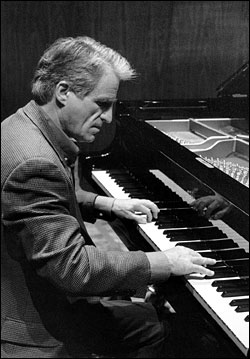BEETHOVEN’S 32 PIANO sonatas have been compared to the New Testamenta monument that has influenced, in one way or another, practically all the piano music written since. Pianists spend their entire careers with them, from the two perky, uncomplicated pieces labeled op. 49 to the profound, even inscrutable personal expression of the arcane last sonatas.
So daunting are the interpretive and technical challenges of Beethoven’s sonatas that University of Washington pianist Craig Sheppard is only now, at 55, tackling his first complete cycleall 32, in chronological order, in seven recitals (the third of which will be at 7:30 p.m. Wednesday, May 21 at Meany Hall, 206-543-4880).
“I suppose I never felt ready for it until now,” he says. “Suddenly, a couple of years ago, I said to myself, ‘It’s time. Either now or never!’ I’ve taught every one of them, excepting the two little op. 49s, and have performed the majority of them, so it’s simply been a matter of filling in the gaps, which has been a lot of fun and not nearly as overwhelming as I might have imagined.”
Sheppard’s performances in his January and March recitals were illuminating. In general, there are two ways to approach Beethoven’s first sonatas: You can emphasize what they have in common with earlier sonatas in the Viennese tradition, or what they don’t the innovations, the unprecedented moments of startling passion and vehemence. Sheppard’s method was subtler. He seemed to hear the sonatas with the ears of Beethoven’s contemporaries: as works that say surprising things in a unique, if not yet avant-garde, voice but in a familiar, even ingratiating, language. His playing was crisp and dashing, relishing Beethoven’s touches of theater from wit (even slapstick) to pathos.
The sonatas on Sheppard’s next recital, opp. 14, 22, 26, and 27, show Beethoven self-consciously starting to experiment. The piano sonatas became the composer’s vanguard worksthe greatest pianist of his time, he used the instrument as a kind of laboratory, and as his compositional style expanded and ripened, the sonatas blazed the trail that his symphonies and string quartets followed. Op. 27, no. 1, is one large movement in eight capriciously contrasting sections; op. 27, no. 2the “Moonlight,” probably the most popular of them allstarts with a slow movement and ends with a sweeping tempest. Almost apologetically, Beethoven retitled these two pieces, emphasizing their unorthodox, fantastical character: Sonata quasi una fantasia, he called them, to disarm conservatives who might carp, “Those aren’t sonatas!”
SHEPPARD HAS FOUND interesting clues to Beethoven’s quest for personal expression in the original manuscripts.
“Beethoven’s handwriting shows so much better than any edition possibly could how he wanted the works to be played,” he explains. “You only have to seeand feelthe energy, the size of some notes compared to others on the page, the space given around certain bars, many of which are very unevenly distributed. All of this is the real Beethoven coming out. I think one of the great tragedies is that at least half the [manuscripts] have gone missing over the years and we will never be able to see what Beethoven meant in those cases. [Since] Beethoven was known via his letters to have been dismayed sometimes at the first editions that came out, any true interpreter of his works is forced to make many arbitrary decisions that might turn out differently in the hands of someone else.”
Sheppard mentions many well-known Beethoven specialists as influences, from Artur Schnabel’s recordings from the 78 era to contemporaries like Brendel, Pollini, Goode, and Perahia. But he admits that “in preparation for this series, I have not listened once to any of those old recordings that influenced my youth. My desire and purpose now is to find within me what the music has to say.”







